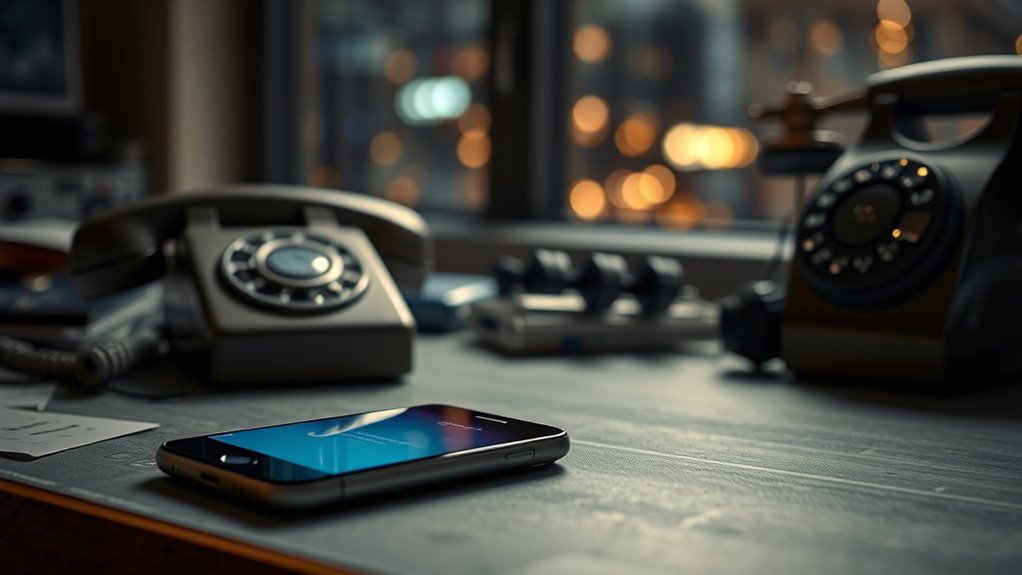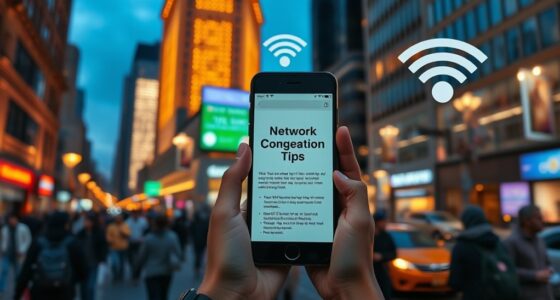During network congestion, texting works better than calling because it uses less bandwidth and is less affected by delays. Text messages are stored and sent once the network clears, making sure your message gets through even when the system is busy. Calls require a stable, continuous connection, which is harder to maintain during overloads. Staying with texting increases your chances of successful communication, and if you stay tuned, you’ll discover how it can be even more effective.
Key Takeaways
- Text messages require less bandwidth and are less affected by network congestion than voice calls.
- Texts are stored and sent later when the network clears, ensuring higher delivery success.
- During emergencies, texts can be quickly sent and received even when calls are jammed.
- Secure texting offers better data privacy and is less vulnerable to interception during peak times.
- Messaging queues and low data usage make texts more reliable and efficient in overloaded networks.

During network congestion, your choice between texting and calling can substantially impact whether your message gets through. When networks are overwhelmed, voice calls often struggle to connect due to the high data demand required for real-time voice transmission. Texting, on the other hand, typically requires less bandwidth, making it more reliable during these stressful times. If you’re trying to communicate in an emergency, sending a quick text can be the fastest way to alert someone that you need help or to confirm safety. Unlike calls, which can drop or be delayed, texts are stored and sent once the network can handle the data, increasing the chance your message arrives intact.
Emergency communication becomes critically important in congested situations. In such moments, you don’t want to risk a failed call when every second counts. Text messages are often stored temporarily by your carrier’s servers and then delivered when the network is less congested. This process guarantees your message gets through, even if a call might drop or be delayed. Plus, during a crisis, voice lines tend to be jammed with many users trying to connect simultaneously, while texts can queue and be delivered once the network clears. Being able to rely on texting in these scenarios can be a lifesaver.
Data security is another key reason texting often wins over calling during network congestion. Voice calls can be intercepted more easily, especially on unsecured networks, posing risks to sensitive information. Text messages, especially those sent via encrypted messaging apps, offer better data security. They’re less vulnerable to eavesdropping, which is essential when sharing private or sensitive information. During network congestion, the likelihood of data breaches or interception increases if you’re not careful. Using secure texting methods helps protect your data, guaranteeing your emergency communication remains private and confidential.
Furthermore, texting consumes less bandwidth, which reduces the load on the network for everyone. This means that during peak congestion, your text is less likely to be affected by the strain on the system. Calls demand a continuous, stable connection that’s harder to sustain when everyone’s trying to connect at once. Texting’s lightweight nature makes it inherently more resilient in these scenarios. This efficiency can be indispensable when trying to communicate quickly without the frustration of dropped calls or failed connections.
Frequently Asked Questions
How Does Network Congestion Affect Call Quality?
Network congestion causes call quality issues by increasing network latency and causing signal interference. When many users are on the network, your call may experience delays, dropouts, or poor audio quality. Signal interference from other devices or network overload makes it harder for your voice to transmit clearly. As a result, your conversation may become choppy or disconnected, making calls less reliable during busy network times.
Can Texting Be Used for Emergency Communication Effectively?
Yes, texting can be a lifesaver during emergencies. It’s like having a direct line to critical messaging and emergency alerts that almost never fail, even when calls drop like flies. You can send quick updates, receive essential info, and stay connected without clogging the network. Texting’s reliability during chaos makes it your best tool for emergency communication, ensuring you get the help and information you need fast.
What Are the Privacy Implications of Texting Versus Calling?
You should consider that texting offers better privacy because encrypted messaging keeps your conversations secure from third-party access. Unlike calls, which can be overheard or recorded, texts typically include options for location sharing that you control, adding another layer of privacy. However, be aware that your service provider might still track metadata such as who you message and when, so always review your privacy settings to protect your personal information.
Does Texting Consume Less Battery Than Calling During Congestion?
Yes, texting generally consumes less battery than calling during congestion. Your device uses less power for text messaging because it requires minimal data transfer and maintains a lower power state when sending or receiving messages. Calls, on the other hand, demand more power for continuous voice data and maintaining the connection. So, if you’re trying to conserve battery, texting offers better battery efficiency and reduces overall power consumption during network congestion.
Are There Any Limitations to Texting During High Network Traffic?
Like trying to send a telegram in a storm, texting during high network traffic has its limits. You might face message delays or failures if network stability drops considerably. While texting generally uses less bandwidth, heavy congestion can still slow down delivery times. So, if the network’s struggling, your texts could get delayed or not go through at all—making it less reliable in extreme situations.
Conclusion
Remember, sometimes a picture or a simple message says more than a call. During network congestion, texting remains reliable and less demanding on bandwidth. It allows you to stay connected without the stress of dropped calls or busy signals. As the saying goes, “A little patience is a virtue,” and in this case, it’s your best friend. So, next time networks clog up, reach for your phone and send a quick text—you’ll thank yourself later.









